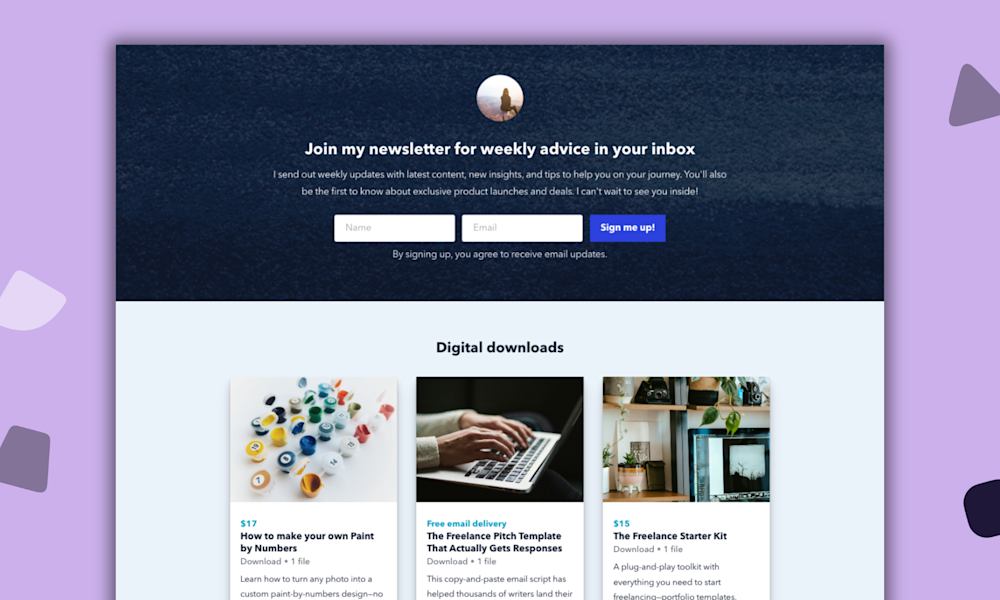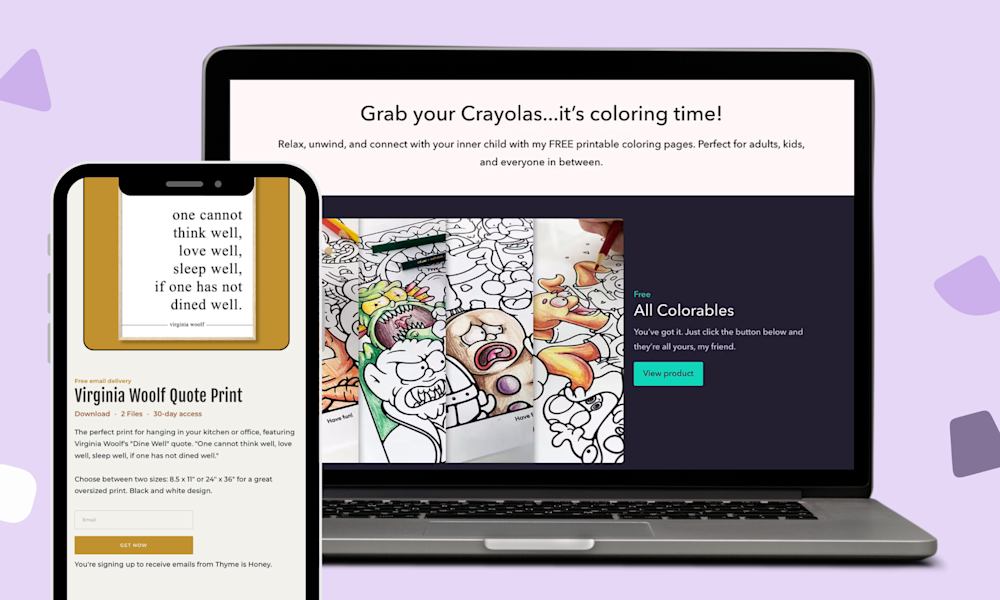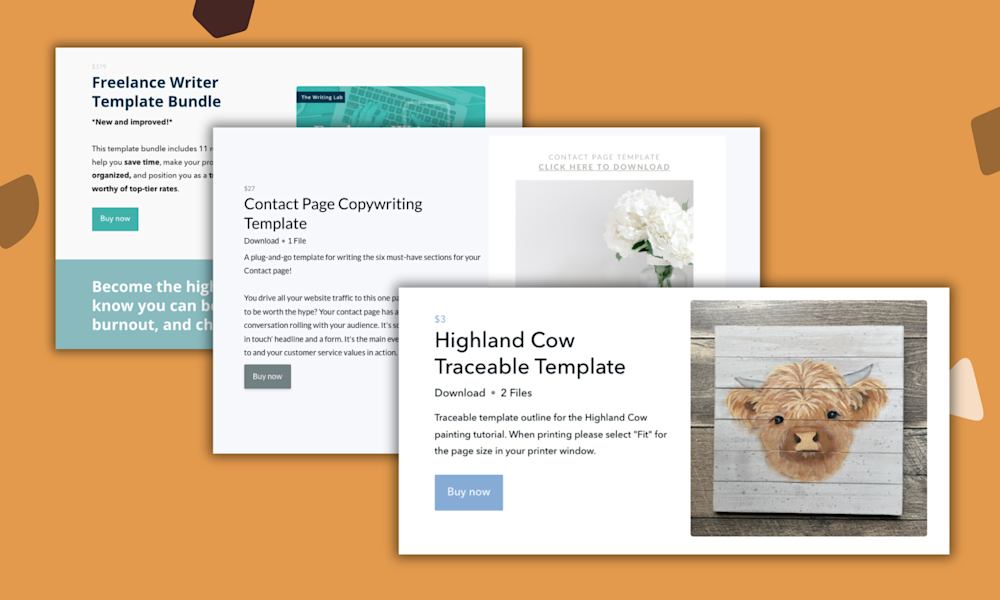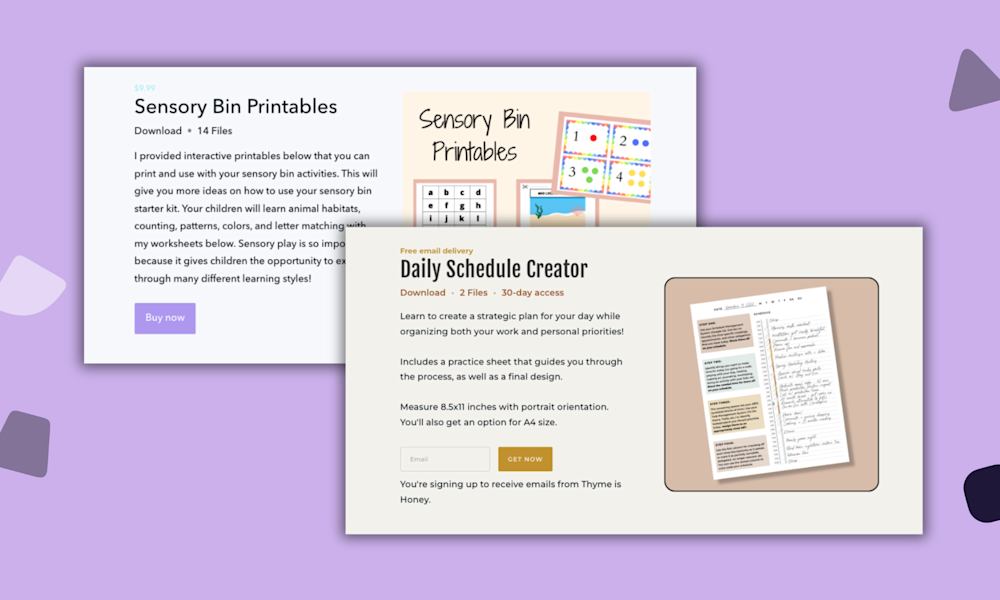You’ve worked hard at crafting your ebook.
It’s chock full of valuable content that’s sure to delight your audience.
Go ahead -- bask in your accomplishment.
After all, you’ve been anticipating the exciting moment of marketing your ebook, so you can start to make money. With the daunting task of writing your ebook behind you, you’re that much closer.
Now, if only you could seamlessly design your ebook to match the excellent material you’ve just authored.
That’s what we’re going to help with today.
How? We bring you five straightforward steps for designing an ebook like the pros do, starting with the part that everyone judges first -- your cover.
Let’s dive right in.
5 straightforward steps to design your ebook
#1. Create a compelling cover
Our first tip for designing your ebook like a pro is to create a cover that attracts the right audience.
In the same way that people make subliminal snap judgments about whether or not they like or trust someone within one second of seeing their face, they make the same call about your ebook based on the cover.
Which means, yes -- people do judge a book by its cover. On a subliminal level, anyway.
So, designing a cover that sends the right message is vital for successfully selling your ebook on your website.
One way to send the right message to your audience is to make sure your graphics are relevant to your ebook’s theme when designing your ebook cover.
For instance, Mark Truscott’s Branches literally features an artistic representation of tree branches on its cover.
You can also weave in your ebook’s theme in subtle ways, like Gunnhild Øyehaug’s Wait, Blink, which features a custom blurry font on paper that appears 3-dimensional.
The design treatment is delicate, but Gunnhild’s book evokes movement and emotion that’s on point with her book’s title and theme.
On top of matching your ebook cover to your theme, if you can reflect your ebook’s genre directly from your cover, even better -- you’ll attract more readers.
Don’t believe me? Here’s proof.
Michael J. Sahno’s Miles of Files earned 122% more clicks after redesigning his cover to more accurately portray his genre.
Michael’s updated cover includes bolder orange- and blue-based design elements that do a better job of alluding to the crime fiction genre than the original cover did.
If you want to attract the right audience like Michael, an effective way to do this is to research book cover trends within your genre, which will give you a better understanding of how to convey your ebook’s content in terms of design.
You can even poll your audience, either through email or in a social media post, and ask them to vote for their favorite cover version.
As for how to design your ebook cover, you can use free handy tools, like Canva, which includes a variety of ebook cover templates to choose from.
Venngage is another free option that also offers multiple ebook cover templates.
On either platform, you simply customize your cover design by swapping out elements with your own content, images, and font choices.
Regardless of which online tool you choose, use graphics that represent both your ebook theme and genre, which will help you attract the right readers.
Once you’ve enticed them with your cover art, it’s time to format the guts of your ebook to keep your readers engaged, which is our next step today.
#2: Format your ebook pages for optimal readability and engagement
Another vital part of designing your ebook like the pros do is to format it properly.
The reason why formatting is so important is it can make or break your readability. After all, you want to create an ebook that’s easy to read and simple to navigate. The easier it is to consume, the more engaged your audience will be, and, in turn, the more they’ll love your brand.
So, a well-formatted ebook is a win all around.
To format your ebook pages, you can use free tools like Draft2Digital or Reedsy, which take care of details like justifying, organizing chapters, and choosing the right fonts for your copy.
For Mac users, consider using tools like iBooks Author or Vellum for your ebook formatting.
These tools turn your written files into professionally formatted ebook pages that align with the industry’s formatting standards.
When you’re writing the content of your ebook, it’s a good rule of thumb to follow these body text settings to make the file-converting process a clean (and simple) run:
-
Use a standard font (i.e., Times New Roman or Arial)
-
Use font size 10, 11, or 12 for the main body
-
Use black font
-
Use standard margins and spacing that’s less than 1.5
-
Don’t go beyond formatting basics of bold, italic, and caps when emphasizing pieces of your content
Basically, when in doubt, use the standard default settings in your writing program, whether Google Docs or Microsoft Word.
But, while tools simplify the formatting process, they don’t take care of everything related to your formatting.
Even if you’re using an online tool to format your written work, it’s important to take the extra step of adding elements to your ebook that engage your readers.
What’s the best way to engage your ebook readers through formatting?
Three words -- make it skimmable.
Yes, much to writers’ chagrin, people skim. In fact, when it comes to reading online content, a whopping 81% of people skim.
You may not want to, but you need to cater to their reading skimming habits.
To cater to your skimming readers (which may include you at the moment as you read this article), format your ebook content with a couple of these scannable content tips in mind:
-
Break up your bulky content into paragraphs using line breaks
-
Use subheads to summarize your section themes
-
Use bulleted lists
-
Highlight key points using bold or italic
-
Include links to helpful resources
Basically, format your written content, so your ebook is engaging and easily readable. Use online formatting tools to arrange your content, so it meets industry readability standards. And be sure to also format your work so readers can skim through it.
Our next step shows you how to format your ebook, so it’s even more engaging through the use of graphics.
#3: Weave in images and visuals
Because online readers are in a deep habit of skimming content, it’s important to do everything you can to keep them engaged with your ebook’s content -- including adding graphics to your content.
Why? Visual content is powerful.
So powerful it keeps people’s learning and affinity levels high.
65% of people are visual learners, by some estimates. So, if you use colored visuals, you’ll have an even greater chance of keeping your readers’ attention, so much so that adding colored visuals increases your readers’ desire to read your ebook by a startling 80%.
Another great way to make your content visually appealing is to enlarge any important quotes, phrases, or stats, just like Hull does in its 5 Ways Centralizing Customer Data Can Grow Revenue ebook.
Including charts and graphs to back up your points in your ebook can go a long way, too. Check out how NewsCred includes a chart in its Definite Guide to Integrated Campaigns ebook to illustrate important points.
That said, there’s a soft caveat coming here -- while including visually pleasing and colored content is important for designing your ebook, they aren’t enough to call it a day.
Go beyond that and represent your brand consistently across the board whenever possible in your ebook. There's a good reason consistency is one of the most universal branding tips for entrepreneurs.
And that reason comes down to the numbers: Consistently presented brands are 3.5 times more likely to achieve excellent brand visibility when compared to brands that aren’t presented consistently.
So, this means keep all your visuals -- including images, charts, graphs, and even your typeface -- on brand.
For instance, keep your color scheme within your brand colors whenever possible, like Marketo does in their 10 Marketing Predictions for a New Decade ebook.
As you can see, Marketo peppers in its brand’s purple and blue color scheme and even include the Marketo logo at the bottom of each page. Even though the branding is subtle, it’s still consistently presented.
Ready for another way to engage your readers? Take it up a notch and go beyond static visuals.
The beauty of creating a digital vs. physical product is you can incorporate engaging content into your ebook beyond still image files -- by adding video.
Video is an amazing format to leverage in your ebook because, these days, video content is king.
54% of consumers want to see more videos from the brands they support, and an incredible 85% of US internet users watch video content online.
This means people are acclimated to consuming video content, so it may be worth the effort in popping in a relevant video that backs up the points you make in your ebook.
Besides, you wouldn't be the first. Dean Koontz, a celebrated, prolific, and wildly successful author, features motion content in some of his ebooks, and the Kindle Store has a growing section dedicated to ebooks that step things up with similar content.
In a nutshell:
Incorporate powerful visual content -- whether colored images, enlarged quotes or stats, graphs, charts, or video -- into your ebook content to engage your readers, and make sure it’s all on-brand.
Now, with both the cover and the guts of your ebook formatted and ready to engage your readers, it’s time to entice them to take action.
#4. Include a CTA
Our fourth step for designing an ebook like a pro is to include a call-to-action (CTA) in your ebook, particularly if it’s a free one you’re using as a lead magnet.
In the same way that emails with one single CTA can increase your clicks by an astounding 371% and your sales by an even more impressive 1,617%, a CTA in your ebook also encourages your readers to engage with and purchase from your brand.
After all, you’ve dedicated the pages of your ebook to helping your reader -- whether solving their biggest problem, educating them, or simply entertaining -- so why not lead them to more of your helpful products and services?
Take HubSpot and SproutSocial, for example. They partnered up to publish an ebook, How to Build a Social Media Strategy Dream Team, and feature two CTAs at the close of the ebook.
Naturally, there’s one CTA for each party’s offering. For their readers who are interested in going deeper into the ebook’s subject matter, they can try HubSpot and SproutSocial’s respective services.
After educating their readers and positioning themselves as experts in their field, the ebook authors naturally become the trusted resource among their audience.
If a CTA that leads to selling your online business ideas seems too salesy for you, then our next example might be more your speed.
HubSpot Academy’s Social Media Certification Workbook, an ebook for beginners about applying social media to your business, does a nice job of closing out its content with a CTA that simply invites dialogue among its readers.
HubSpot Academy's instructor, Ai Addyson-Zhang, leaves a personal note at the end, asking readers to engage with the academy by tweeting their feedback and sharing input.
However you do it, the main takeaway is to include a CTA at the end of your ebook that encourages your readers to take action with your brand after consuming your content.
OK. If you’ve made it this far, you’ve completed all the heavy lifting of designing your ebook. There’s just one final step for wrapping up your ebook design.
#5. Convert it to a downloadable file
Your final step is to convert your ebook to a digital download that you can sell directly from your site.
Check out tools like Publishdrive, which easily converts your written content from .docx files to .epub or .mobi files.
Some of the most popular ebook file formats are:
-
.epub
-
.mobi
-
.azw
-
.pdf
As far as choosing an ebook file format for your ebook, you may want to consider ebook-reader compatibility in this chart:
-
.txt - TXT is compatible with all platforms but has limited formatting.
-
.azw - AZW is proprietary and mainly supported on the Amazon Kindle.
-
.epub - EPUB is free, open standard, and supports a wide range of graphic and video elements.
-
.mobi - MOBI is workable on a variety of devices, but not publicly available, and doesn’t support video or sound.
-
.pdf - PDF is popular and compatible but has limited reflowing formatting.
For your convenience, here it is in chart form:
If you can, create as many formats as possible, so you’re covering every possible consumer. But if you can’t, or just don’t want the hassle of it, PDF is a solid choice for most people.
Either way, if you’ve followed our steps to now, you’ve officially designed an ebook like a pro. Nice work -- now if only there were a place to host it . . .
Time to design your ebook like the all-star you are
Designing a professional-looking ebook can be done without actually being a pro designer if you follow a few simple steps and principles.
Let’s summarize:
-
Step #1. Create a compelling ebook cover that aligns with your content’s theme and genre.
-
Step #2. Use online formatting tools and formatting principles to make your ebook easily digestible, readable, skimmable, and engaging.
-
Step #3. Mix in well-branded visual content that breaks up -- and backs up -- your written material to further engage your readers.
-
Step #4. Include a strong CTA at the end of your ebook to entice readers to take action with your brand, especially if it’s a free ebook or lead magnet.
-
Step #5. Convert your ebook to a downloadable file that you can sell for a profit on your site.
Finally, if you’re ready for the next exciting step of publishing and selling your ebook, then give this 30-day trial with Podia a spin. Our all-in-one platform makes managing your website and digital products a cinch, and you can sell as many ebooks as you can create.
Here’s to designing an ebook that matches the valuable content you share with the world.



